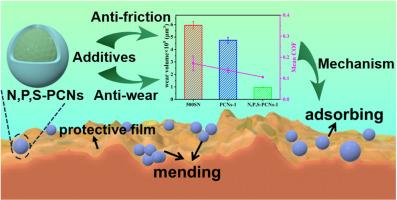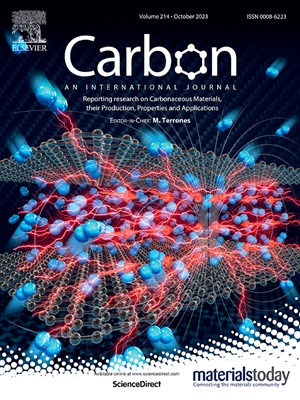制备多元素掺杂的聚苯乙烯核壳结构碳纳米球,作为润滑添加剂改善摩擦学性能
IF 10.5
2区 材料科学
Q1 CHEMISTRY, PHYSICAL
引用次数: 0
摘要
本研究通过对包覆有聚(环三膦-4,4′-磺基二苯酚)(PZS)的超交联聚苯乙烯纳米球(HPSs)进行碳化,成功合成了多元素掺杂的核壳结构碳纳米球(N,P,S-PCNs)。通过磺酰二苯酚作为交联剂,磷酰氯三聚体可在 HPSs 表面原位组装,形成聚(磷酰氯三聚体)膜,得到 HPSs@PZS。随后,将 HPSs@PZS 在 N2 气氛下进行高温煅烧,具有良好封装能力的 PZS 将 N、P、S 有效地掺入到碳纳米球中,得到具有核壳结构的多元素(N、P、S)共掺杂碳纳米球(N、P、S-PCNs)。制备的 N,P,S-PCNs 作为润滑油添加剂具有优异的分散性和稳定性,可有效降低摩擦(降低至 0.106)和磨损(降低 84.0%)。N,P,S-氯化萘的润滑性能之所以出众,是因为纳米球具有进入摩擦对之间的间隙并在表面形成沉积膜的卓越能力。此外,纳米球还能与基体表面发生化学反应,形成化学保护膜。复合保护膜(沉积膜和化学保护膜)大大增强了润滑剂减少摩擦和抗磨损的能力。本文章由计算机程序翻译,如有差异,请以英文原文为准。

Preparation of multi-element doped carbon nanospheres with core-shell structure derived from polystyrene as lubricating additives for improving tribological behavior
In this study, the multi-element doped carbon nanospheres with core-shell structure (N,P,S-PCNs) have been successfully synthesized through the carbonization of hyper-cross-linked polystyrene nanospheres (HPSs) encapsulated with poly(cyclotriphosphazene-co-4,4′-sulfonyldiphenol) (PZS). The phosphonitrilic chloride trimer can in-situ assemble on HPSs surface, forming a poly(phosphonitrilic chloride trimer) film via sulfonyldiphenol as cross-linking agent to obtain HPSs@PZS. Subsequently, the HPSs@PZS undergoes high-temperature calcination under N2 atmosphere, and PZS with a well-preserved encapsulation capability efficiently incorporated N, P and S into carbon nanospheres to gain multi-element (N,P,S) co-doped carbon nanospheres (N,P,S-PCNs) with core-shell structure. The prepared N,P,S-PCNs exhibit exceptional dispersibility and stability as lubricant additives, effectively mitigating friction (reduced to 0.106) and wear (decreased by 84.0 %). The lubrication performance of N,P,S-PCNs is exceptional due to the nanospheres' remarkable ability to enter the gaps between friction pairs and form a deposition film on the surfaces. Moreover, the nanospheres can undergo a chemical reaction with the matrix surface, resulting in the formation of a chemical protective film. The composite protective film (deposition film and chemical protective film) significantly enhances the lubricants' ability to reduce friction and resist wear.
求助全文
通过发布文献求助,成功后即可免费获取论文全文。
去求助
来源期刊

Carbon
工程技术-材料科学:综合
CiteScore
20.80
自引率
7.30%
发文量
0
审稿时长
23 days
期刊介绍:
The journal Carbon is an international multidisciplinary forum for communicating scientific advances in the field of carbon materials. It reports new findings related to the formation, structure, properties, behaviors, and technological applications of carbons. Carbons are a broad class of ordered or disordered solid phases composed primarily of elemental carbon, including but not limited to carbon black, carbon fibers and filaments, carbon nanotubes, diamond and diamond-like carbon, fullerenes, glassy carbon, graphite, graphene, graphene-oxide, porous carbons, pyrolytic carbon, and other sp2 and non-sp2 hybridized carbon systems. Carbon is the companion title to the open access journal Carbon Trends. Relevant application areas for carbon materials include biology and medicine, catalysis, electronic, optoelectronic, spintronic, high-frequency, and photonic devices, energy storage and conversion systems, environmental applications and water treatment, smart materials and systems, and structural and thermal applications.
 求助内容:
求助内容: 应助结果提醒方式:
应助结果提醒方式:


